VI. Pacific's Service Quality Performance
A. Introduction
We now turn to an analysis of Pacific's service quality performance. (We discuss Verizon's performance in a similar section below.) In summary, Pacific shows problems with its service quality and related matters in the following areas:
· Repair intervals, or the time it takes Pacific to complete repairs once a customer notifies the company of problems and number of trouble reports, especially reports of service outages (see Section entitled "Network Reliability, Trouble, and Repair - Pacific," below).
· Answer times (see Section entitled "Answer Times - Pacific," below).
· An increasing pace of formal complaints aimed at serious service quality problems and related issues (see Sections entitled "Complaint Data - Pacific, Formal Complaints," and "Marketing - Pacific," below).
· Negative trends in service quality in some of the Commission's informal complaint data (see Section entitled "Complaint Data - Pacific, Informal Complaints," below).
· A significant deterioration in the perceptions by residential and small business customers of Pacific's service quality (see Section entitled "Customer Satisfaction and Service Quality Surveys - Pacific," below).
· Failure by Pacific to file required service quality reports (see Section entitled "Other Customer Surveys - Pacific," below).
In addition, we are concerned that, in Pacific's increasing use of affiliates to offer services formerly provided by the regulated utility (see Section entitled "Movement of Functions to Unregulated Affiliates - Pacific," below), Pacific has posed challenges to our regulatory authority that may be detrimental to our ability to protect service quality.
B. NRF Incentives and Service Quality - Pacific
1. Introduction - Pacific
The parties dispute the impact of NRF incentives on service quality. TURN claims that NRF creates incentives to save money at the expense of service quality. It contends that NRF's emphasis on cost cutting and revenue enhancement has led to deterioration of service quality. It also believes the introduction of new technology affects service quality and may result in discrimination among technology "haves" and "have nots." It alleges that NRF creates incentives for the regulated utility to move functions outside the utility to an unregulated environment, which can leave regulated customers without adequate service. It disputes Pacific's claim that its other rates subsidize basic service, which Pacific claims minimizes its ability to cut costs for - and therefore undermine the quality of - basic telephone service. It does not believe that competition provides an incentive for good service quality. Finally, it believes that positive change will only result from active regulation in connection with NRF.
TURN points to evidence demonstrating that NRF incentives to cut costs and increase revenues have indeed lowered service quality. TURN bases its allegations about repairs, installation and answer times on the reporting we discuss elsewhere in this decision. It claims as to Pacific that the data show adverse impacts causing slow repairs, slow installation, slow telephone answer times, erroneous late payment charges, errors resulting from outsourcing company functions, charging for services that were formally free, and marketing abuses.
TURN relies on other formal Commission proceedings for its claims about late payment charges, outsourcing, service charges, marketing abuses, and deteriorating service quality.
Similarly, ORA alleges that under NRF Pacific has "reduced [its] quality of service, grossly inflated staffing claims, . . . moved portions of the labor force out of California . . . , and had sustained facilities shortages. . . ."48
Pacific responds that these claims indicate fundamental disagreement with incentive-based regulation and that the criticisms do not belong here. Pacific states that in fact NRF gives it "strong incentives to provide high-quality service, to retain as many customers as possible, and thereby reduce the opportunity for competitors to `cream-skim' the most profitable, lower cost, and high-usage customers."49 It claims that the Commission adequately regulates service quality under NRF through its GO 133-B requirements and other monitoring reports, and that "[t]he Commission has not taken any steps to rescind NRF because . . . Pacific has consistently met or exceeded the Commission's benchmarks under GO 133-B."50
Were we at the beginning of NRF process, Pacific's complaint might have more merit. However, we now have many years of experience behind us, and the systemic concerns the parties raise are relevant to whether the system we devised works as we intended or requires revision. A key purpose of this proceeding is to assess how service quality has fared under NRF. Contrary to Pacific's assertion, rather than expressing a fundamental disagreement with incentive-based regulation, concerns raised by parties may instead merely point to areas of incentive regulation requiring special attention from the Commission. Because this is the first chance the Commission has had since the institution of NRF to examine each of our formal proceedings together, TURN appropriately relies on these Commission proceedings as evidence supporting its claims.
In raising a concern that an emphasis on cost cutting can diminish service quality, TURN restates the Commission's own concern when it first instituted NRF.51 Indeed, it was precisely because of the Commission's concern that the carriers would save money by skimping on service quality that we initially established service quality monitoring requirements, and now undertake an examination of NRF's effects on customers through this proceeding.
The specific service quality data adduced in this proceeding and addressed elsewhere in this decision illustrates that TURN's and ORA's concerns are not speculative, and that Pacific's claims to be in compliance with all of the Commission's requirements are not entirely accurate. Indeed, we find that Pacific's results show poor performance in at least some service quality areas. While it is difficult to tell whether Pacific's service quality would have fared better under a traditional regulatory scheme than under NRF, the company's performance in certain areas demonstrates that service quality problems can and do exist, and in some cases are increasing, under the current regulatory regime.
2. Movement of Functions to Unregulated Affiliates - Pacific
The parties also dispute the effect of Pacific's admitted practice of moving functions outside the utility to affiliates on service quality. TURN claims that the tendency to move functions outside the utility can adversely impact service quality, while Pacific asserts that the practice saves money, is more efficient, and has no harmful impact on service quality. Pacific claims that TURN is merely "suggest[ing] a fishing expedition where the Commission would require additional data and analysis without any regard for the costs that Pacific would bear to undertake this additional reporting.52
As discussed in connection with the Pacific audit,53 many of the functions previously carried out in the regulated entity have been consolidated in unregulated affiliates such as SBC Operations. While Pacific's witness assures us that the Commission can still regulate Pacific's services even after it transfers functions to unregulated affiliates,54 we take official notice pursuant to Rule 73 of the Commission's Rules of Pacific's contrary position in another proceeding. There, Pacific contended that the Commission could not compel discovery from an out-of-state affiliate.
In connection with the Commission's examination of Pacific's pricing of unbundled network elements (UNEs) available to competitive local exchange carriers, Pacific refused to produce information supporting the UNE costs it sought to recover in other states for SBC-affiliated companies, contending such information was beyond the regulatory reach of the Commission. The Assigned Commissioner was forced to sanction Pacific for such conduct.55 The full Commission affirmed the sanction in D.02-05-042. Pacific's stance there that the Commission lacked regulatory authority to order an affiliate to produce cost information gives us little comfort that Pacific will be forthcoming in the future as to data housed within affiliates.
Nor is it clear that we can count on Pacific to maintain adequate records related to the service quality of its affiliates. In the context of our investigation of complaints about Pacific's DSL service earlier this year, we found that Pacific had failed to maintain adequate records of complaints filed against its ASI affiliate, which provides DSL service to customers. In the OII initiating the proceeding we noted the following:
Pacific Bell's quarterly reports for the year 2001 report no complaints against SBC-ASI in any month. Considering the number of unauthorized billing complaints received by CAB against SBC-ASI in 2001, the amount of dollars Pacific Bell adjusted to SBC-ASI customers' bills during that period, and staff's allegation that written cramming complaints against SBC-ASI were forwarded by CAB to Pacific Bell, we find it appropriate to consider whether Pacific Bell failed to maintain accurate and up-to-date records of consumer complaints and failed to report these complaints against its affiliates in its quarterly reports submitted to CSD.56
In adopting a settlement of the investigation and an accompanying complaint case, we found that in fact Pacific had failed properly to maintain or report DSL-related complaints in violation of D.00-03-020, as modified by D.00-11-015.57 Importantly, moving services and functions to affiliates not only makes more difficult the Commission's job of ensuring good service quality, it also undermines the consistency and validity of Pacific's service quality information reported under GO 133-B and elsewhere. Pacific and its affiliates acknowledged in the settlement adopted by D.02-10-073 that customers experienced "unresponsive service, such as long waiting queues . . . ."58 However, because DSL service was moved to an affiliate, Pacific does not include DSL-related data in its service quality measures reported to the Commission.59
Therefore, we agree with TURN's concern that transfer of functions formerly provided by the regulated utility to unregulated affiliates may be detrimental to service quality and our ability to detect that deterioration. We do not intend to allow this to happen.
However, it is best that we consider measures to ensure that the Commission does not lose regulatory authority over ratepayer-affecting functions - regardless of what entity carries them out - in Phase 3B. The scoping memo for this proceeding designates Phase 3B as the time to focus on modifying or strengthening the NRF mechanism to ensure that ratepayers are protected.
It may well be that we should impose specific reporting requirements on Pacific and its affiliates, or require Pacific to obtain our approval before transferring any functions to an unregulated affiliate. Indeed, Pub. Util. Code § 851 et seq. already gives us such power, at least under some circumstances. We will examine the implications of Pacific's transfer of formerly regulated functions into centralized operations or other unregulated affiliates in Phase 3 of this proceeding. Parties should make specific proposals in briefing and testimony they submit at that time.60
3. Incentives to Cut Costs - Basic Service - Pacific
The parties also disagree about whether Pacific has incentives to cut costs and degrade service quality under NRF in the area of basic service. TURN claims that Pacific has incentives to cut costs and degrade service quality even for basic service. Pacific claims that basic service prices are already subsidized (priced below cost) and that it cannot enhance revenue by cutting costs on that service.
Pacific's claim is counterintuitive. As TURN points out, "Pacific is always better off if it can reduce costs. Either its profits will increase or its losses will shrink."61 Thus, we reject Pacific's claim that it has no incentives to cut costs so deeply as to impair service quality simply based on the premise that basic telephone service is subsidized. (Whether Pacific's underlying claim of subsidy has merit is beyond the scope of this proceeding.)
4. Effect of Competition on Service Quality - Pacific
The parties also disagree about the effects of competition on service quality. TURN notes that even assuming, arguendo, that competition is present in some of Pacific's markets - for example, in the California DSL market - there is no guarantee that service quality will be good. "The extant competitive pressures were not sufficient to force Pacific and its affiliate Advanced Services, Inc. (`ASI') to provide high quality Digital Subscriber Line (`DSL') service to the thousands of Californians who experienced the billing problems that led to the settlement agreement in C.02-01-007."62
Pacific claims that, "as competition increases, this incentive [to maintain service quality which does not adversely affect the demand for Pacific's competitive products] becomes `even more important.'"63 As for the ASI case, Pacific claims that "[t]he billing problems associated with ASI are related directly to the difficulties associated with meeting new regulatory requirements, not competitive pressures in the marketplace."64 We discuss the ASI case in the Section entitled "Formal Complaints - Pacific," below, and agree that the problem with Pacific's DSL service was severe in spite of the presence of competition.
Moreover, there remains a factual dispute over whether there is adequate competition in the local service market to put upward pressure on service quality. In our recent decision allowing Pacific into the long distance market, we found that competition in this market is less than robust: "Local telephone competition in California exists in the technical and quantitative data; but it has yet to find its way into the residences of the majority of California's ratepayers."65
Nor is it established that competition safeguards service quality. As we observed in our recent Service Quality OIR:
It has now been over four years since we issued R.98-06-02966 and nearly seven years since local exchange competition was authorized. We have concerns that our policies in pursuit of increased competition are insufficient to ensure high quality telephone service for all telephone subscribers, and especially for residential and small business customers.67
Thus, we agree with TURN that competition under NRF does not alone ensure high quality service, and that we must continue to be vigilant in monitoring NRF LECs' performance if we are to preserve and enhance service quality. We will attempt to fashion regulatory changes related to these findings in Phase 3, but urge the parties to be specific at that time about what precisely they seek. As the record stands, we have several claims before us, many of which have merit, but little in the way of detailed recommendations for how to ensure incentive based regulation like NRF maintains and enhances service quality. We expect the parties to present such recommendations in Phase 3B of this proceeding.68
C. Service Quality Performance - Direct Measures - Pacific
We now examine Pacific's service quality data. First, we discuss general criticisms of the way in which Pacific maintains its data. Then we discuss the results of its performance on the measures we list above. We conclude that Pacific shows service quality problems in the area of repair intervals, trouble reports, business office answer time and trouble report service answer time. We are also concerned that the pace of serious formal complaints involving and decided against Pacific has increased under NRF, and that the Commission's informal complaint data about Pacific shows several negative trends.
1. Accuracy of Pacific's Data
a. General Issues
A key issue in the proceeding concerned the accuracy of the service quality data that Pacific reports to the FCC as part of its ARMIS reporting obligations. ORA claims that even where Pacific reports positive ARMIS results, the results are unreliable because of errors in the underlying data. Initially, ORA claimed Pacific provided ORA inaccurate installation data for the period 1998-2001. It later changed that assertion to limit the period of claimed inaccuracy to 1998-99, and we limit consideration of the accuracy of Pacific's data to this time period.69
ORA relied principally on the work of Linette Young in this area. Ms. Young downloaded Pacific's raw data into a database format, and then compared it to Pacific's summary data as reported in ARMIS. Where there were inconsistencies across these two sets of data, ORA assumed the ARMIS reports were inaccurate. Ms. Young made many corrections to her data over time as Pacific pointed out problems.
Ultimately, it became apparent that the data mismatches Ms. Young found were due not to Pacific's misrepresentations, but rather to differences between the raw data Ms. Young examined and the data Pacific uses to report to regulators. For example, Pacific modifies its raw data to remove certain types of telephone services that the ARMIS regulatory requirements do not include. We find, therefore, that ORA did not establish that Pacific misreports its installation service results. Therefore, we deny ORA's recommendation that we conduct an audit of Pacific's historic installation data to determine the extent of data error and its subsequent impact on reported service quality results during the NRF period. We do not agree that such an audit is appropriate, since we conclude that ORA did not show that Pacific's installation data are inaccurate.70
However, Pacific should have been far more helpful to Ms. Young in pointing out problems with Pacific's data up front. Pacific knew that ORA had requested raw data to allow it to test Pacific's results.71 Rather than simply waiting until Ms. Young conducted her analysis and pointing out flaws after receiving her testimony, from the outset Pacific should have explained in detail how it translates the raw data to the reports it makes to regulators.
One of the key allegations the auditors made during the audit of Pacific Bell, which we consider in a separate Phase 2B decision, was that Pacific was not cooperative during the audit. We find that Pacific failed to cooperate with ORA in adequately helping it to understand Pacific's data. Had Pacific clarified its data from the outset, Ms. Young may have been able to present a clearer picture. As it was, Ms. Young had to change her analysis each time Pacific - belatedly in our view - explained problems in translating its raw data to reports made for regulatory purposes. In the end, the proceeding could have been much more productive had all such translation errors been resolved beforehand so that Ms. Young could make a true assessment of whether Pacific's data were accurate.
Pacific asserts that we lack authority to order corrective measures if ORA proved that Pacific was mis-reporting its service quality results under ARMIS. Pacific claims that because the alleged errors were in ARMIS data, "the FCC, not the Commission, should determine whether these data should be audited because the FCC is in a better position to evaluate reporting under its rules."72 We disagree, as we too rely on ARMIS data to assess Pacific's service quality and have an interest in ensuring the data's accuracy. Had ORA proven serious errors exist in Pacific's data, we could have ordered an audit pursuant to our authority under Pub. Util. Code §§ 314(a) and 701.
We next address ORA's specific allegations regarding the accuracy of Pacific's data.
b. Specific Alleged Inaccuracies in Pacific's Data
(1) Installation Orders
ORA claims its analysis shows that Pacific closes installation orders before they are complete. This would have the effect of understating installation intervals in regulatory reports. ORA bases its conclusion on its examination of four informal complaints from residential customers who ordered multiple telephone lines at the same time. These lines were to be installed at the same address on the same commitment date. Ms. Young testified that when it was discovered there were not sufficient facilities available to install both lines, "apparently what occurred was Pacific installed one line, closed the order and then reopened or initiated a second order for the second line." ORA is speculating on this point in its use of the term "apparently what occurred." Pacific pointed out that ORA was speculating, and also stated that "lack of facilities for four customers does not constitute a widespread problem."
We agree that there is not enough evidence in the record for us to conclude that Pacific is closing installation orders prematurely. However, from our review of the record, Pacific does not address whether it ever closes out an order containing multiple lines for installation after the first line is installed, and then opens a new order for the subsequent lines. Pacific witness Resnick admitted that "you could have upwards of five, six lines and they would all be installed on one service order."73 It may be that Pacific keeps the entire service order open until the final line is installed. However, it is counterintuitive that it would do so since such an approach would tend to exaggerate installation intervals, which is not in Pacific's interest.
Because the record is unclear on this issue, we order Pacific to file and serve data in the form of a compliance filing in this docket that affirmatively addresses this point within 30 days of the effective date of this decision. Pacific shall answer the following questions under oath in its submission:
· Has Pacific at any time during the period 1990-2002 closed installation orders containing multiple lines to be installed on the same order after a portion of - but not all - the lines were installed?
· If the answer to the previous question is yes, produce an annual summary of the number of such orders.
· If Pacific reports that any multi-line order was closed before all lines associated with that order were installed, explain in detail how Pacific accounts for such orders when calculating its installation intervals for purposes of any regulatory reporting requirements.
(2) Duplicate Records
ORA also argued that the presence of "duplicate" records among the data Pacific provided it indicates there are errors in Pacific's data. However, ORA states in this regard that "ORA does not claim that all duplicate records are erroneous records,"74 and indeed later appears to concede that "the duplicate records should be included" in Pacific's calculation of its installation intervals.75 ORA also confusingly asserts that,
[t]he "erroneous duplicate records" that Pacific refers to are the same anomalous records (orders for basic service that do not contain commitment dates), which Pacific has previously claimed are not erroneous records. After having argued for the inclusion of the duplicate and anomalous records, Pacific cannot now claim that these `erroneous duplicate records' are erroneous.76
It appears from its statement that ORA no longer claims there is a problem with Pacific's data due to the presence of duplicate records, and we therefore make no finding on this issue.
(3) Anomalous Records
ORA also claims there is a problem with "anomalous records" - records without "commit dates" (dates on which Pacific committed it would complete an installation). ORA's witness believed these records were suspicious based on her belief that "no order for services could flow through Pacific's systems without a commitment date." She claims Pacific told her of this restriction several times, but submitted no written evidence in the record of such a representation by Pacific. Indeed, the evidence is to the contrary. As Pacific points out, it is appropriate that certain orders - related to "supersedures" where a new resident at an address takes over the phone service of the existing customer - not contain "commit dates."
(4) Held Orders
ORA also challenged Pacific's held order data. Here there is more merit to the claim, but our decision turns more on an interpretation of GO 133-B than on the quality of Ms. Young's data. GO 133-B defines a held order as "[r]equests for primary (main) telephone service delayed over 30 days for lack of utility plant." ORA and Pacific strongly disagree on the interpretation of the term "primary telephone service." ORA contends that "primary service" is a class of service that includes basic exchange service and that the sequence of lines to an address is not a factor in the definition of primary service.
Pacific defines "primary service" as the first line into a home. ORA claims that Pacific is erroneously relying - out of context - on a definition contained in our rules for the California High Cost Fund-B (CHCF-B), which define a "primary line" in this manner: "Primary Line: For the purposes of the CHCF-B, `primary line' is the first line to [a] household."77 This difference in interpretation clearly affects Pacific's reporting of held orders. If, as ORA contends, Pacific is supposed to be counting all lines into the home as long as they deliver "basic exchange service," then its held order figures likely would be far higher than Pacific reports.
We agree that GO 133-B is ambiguous on this point and that either interpretation is valid. We therefore do not take action against Pacific at this time. We note, however, that our Service Quality OIR is taking a close look at GO 133-B and intend to consider this definitional issue in that forum. We question whether it makes sense for held order reporting to apply only to first lines into a home. Held orders are customer affecting whether they relate to the first line into a home or to subsequent lines.
Next we discuss Pacific's objective results on service quality data.
2. Installation - Pacific
The first objective category of service quality the parties addressed is installation. We find that Pacific has had minor problems in this area. Our biggest concern is that it is difficult to judge Pacific's performance because of the way it keeps its data, as we discuss below. In Phase 3B, parties should address how to alleviate the concerns we raise here.
There are two basic types of installation data: 1) data regarding installation intervals (i.e., the time it takes for the carrier to install phone service) and 2) data regarding installation "commitments met" (i.e., how often the carrier meets its commitments to its customers regarding when the carrier will install service).
ORA's principal complaint was that Pacific's installation data were inaccurate - a claim we address (and generally reject) above. ORA also claimed that its "analysis of Pacific's MCOT reporting of held orders showed that Pacific was the second worst performer in terms of held orders when compared with the other 12 SBC companies in other states."78 Pacific claimed in response that its expert's regression analysis of the same MCOT data, which produced a more positive result, was more reliable, but otherwise did not refute ORA's claim.
TURN alleged that Pacific's staffing is inadequate to ensure prompt installation, citing a 1996 complaint, A.95-12-043/C.96-02-002/D.97-03-021.79 We discuss formal complaints in the section entitled "Other Direct Measures of Service Quality - Complaints, below) and do not repeat that discussion here. TURN "[took] no position on the content of the GO 133-B installation data of Pacific,"80 but alleged that Pacific's ARMIS performance showed periods of decline and improvement for residential and business installation intervals.81
Pacific claimed it had met and exceeded the GO 133-B section 3.2.a "Installation Commitments" standard for all of the NRF period.82 With regard to ARMIS data, Pacific claimed that, "both residential and business installation intervals in 2001 are below the level they were in 1994, the first year the data were reported."83
According to the data in the following graphs we derived,84 Pacific's ARMIS performance on installation intervals (residential and business) was generally consistent over the 1994-2001 period. Pacific's data were slightly worse than Verizon's in 2000-01:
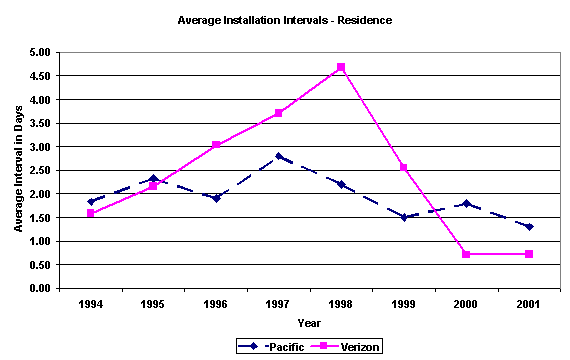
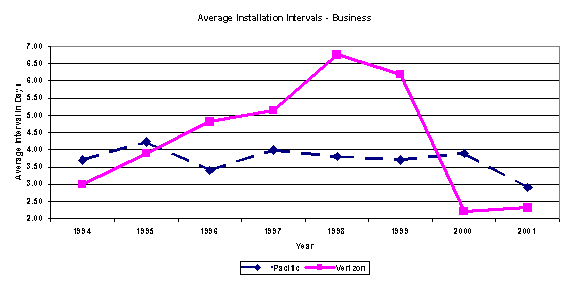
Pacific's residential installation "commitments met" data were consistently good from 1993-2001, with the exception of a dip in "commitments met" in late 1997. For business customers, the percentage of commitments met declined notably from 1997 through 2000, improving again in 2001.
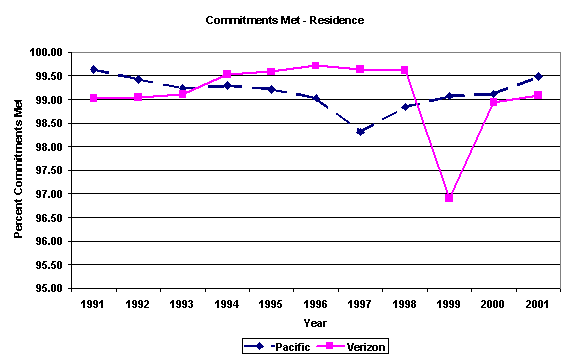
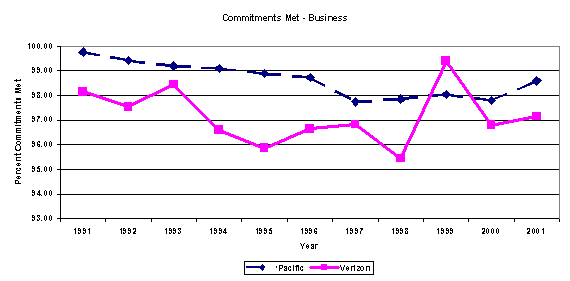
We also note that on its MCOT reporting, Pacific's installation reporting showed that Pacific showed negative spikes in California for the period July 1999-June 2001 in the percentage of installation orders completed within 5 working days (especially residential customers)85 and in the percentage of installation orders delayed over 30 days (business customers).86
With respect to Pacific's installation data, ORA asserted that, "[Pacific's] ARMIS installation orders also include orders for vertical services such as Caller-ID and call waiting, as well as jack installations, etc. . . [and the] . . . increase in total installation orders reflects both the increased demand for access lines, and demand for new vertical services marketed in California during the mid to late 1990s."87 ORA alleged that in 1999, for example, Pacific had approximately 10 million more orders for vertical services and other local services only than it did for orders for basic service, and that vertical services orders contributed to the low reported average installation intervals because vertical services orders are completed within a day of placing the order resulting in installation intervals of 0 or 1 day.
We find that Pacific includes vertical services orders in its data. Pacific can install these services quickly and in automated fashion without dispatching a service technician, so including vertical services orders skews its data toward shorter installation intervals. The record lacks evidence on whether Verizon also includes vertical services orders in its data, so we are unable to conclude that Pacific's and Verizon's data are comparable.
While Pacific asserts that "in most cases, Pacific's recent performance has improved relative to most of the years in which data were reported,"88 it did not show that the improvements in installation intervals was the result of actual improvement in performance instead of the result of an increasing proportion of "short interval" vertical services orders in the mix of installation interval data reported under ARMIS.
Finally, as our previous discussion reveals, Pacific's interpretation of the GO 133-B held order requirement causes it consistently to undercount orders held more than 30 days. Thus, despite Pacific's claims of a near-perfect GO 133-B installation record over the NRF period, the true count of held orders may be far higher than what Pacific reports.
Overall, while we find some problems with Pacific's installation performance, our chief concerns relate to Pacific's counting of held order data, its satisfaction of commitments for business customers, and whether Pacific's inclusion of vertical services orders in its ARMIS installation data causes it to present a more positive picture than is warranted. We order that Pacific correct its method of counting held orders in this decision. In Phase 3B, parties should be prepared to address how to address the latter issue.
3. Network Reliability, Trouble, and Repair - Pacific
Overall, we find that Pacific's repair performance over the NRF period has exhibited significant problems. While the intervals of time its customers wait for repairs have decreased lately - starting in 2001 - as reported in Pacific's ARMIS 43-05 reports, Pacific's performance was worse in 2000 than in 1994 on several important measures.89 It is too soon to know what the trend will be in the future based solely on Pacific's 2001 results. Moreover, just because Pacific's current statistics are acceptable does not mean that we should overlook negative trends in the past.
In D.01-12-021, the Commission noted that Pacific's "average initial repair interval for residential customers increased 45 percent between 1996 and 2000" (with its residential repeat trouble reports per 100 lines peaking in 199890) and that in "every year since 1996, Pacific's mean time to restore service to residential customers [was] higher than the 1996 base year."91 The Commission found "a sharp decline in service quality of nearly 50% over a mere four years coupled with Pacific's knowledge thereof and its lack of an attempt to remedy the deterioration."92 We concluded that, "The Commission cannot find that SBC Pacific's service quality is excellent when the initial out-of-service repair intervals for residential customers has (sic) increased 45% since 1996."93
Pacific's results improved beginning in 2001, but, as TURN notes, ORA filed a complaint in November 2000, which may have caused Pacific to be more vigilant from then on.94 Furthermore, in D.01-12-021, the Commission instituted a system of automatic penalties if Pacific's repair times failed to meet standards established by that decision. Given the timing of ORA's complaint and the Commission's imposition of penalties, it is fair to infer that regulatory intervention had something to do with Pacific's improved performance. We believe our continued vigilance and enforcement are needed to ensure good service quality. Without such scrutiny, service quality could deteriorate. Indeed, we have so opined in other contexts: "Pacific Bell has exhibited a pattern of regulatory compliance during periods of special oversight, only to be followed by noncompliance in furtherance of Pacific Bell's revenue goals when the special oversight ends."95
The evidence establishes that Pacific also showed problems in the following areas:
· Pacific's business customers' initial out-of-service96 repair intervals rose from 11.56 hours in 1994 to 16.5 hours in 2000. While the interval dropped to 12.5 hours in 2001,97 it is too soon to tell if the trend toward improvement will continue.
· Pacific's business customers' repeat out-of-service98 repair intervals rose from 12.9 hours in 1994 to 18.5 hours in 2000. Once again, performance improved in 2001 - with the interval dropping to 13.9 hours during that year99 - but we remain concerned about the prior trend.
· Pacific's ARMIS 43-05 data showed that the number of Pacific's initial trouble reports for conditions other than out-of-service conditions sharply increased from 1994-2001.100 These trouble reports contain complaints about problems of poor call quality, call interruption and static on the line - clearly problems of consequence to customers.
· Pacific's residential customers' initial "all other [trouble] reports" rose from 622,310 in 1994 to 1,127,512 in 1999, dropping to 916,431 in 2001. It is too soon to tell whether the recent improvements will continue consistently.
· Pacific's repeat residential "all other [trouble] reports"101 rose from 125,231 in 1994 to 162,035 in 2001.102
· Pacific's residential customers' initial and repeat all other trouble reports per million lines rose from 65,286 reports in 1994 to 83,153 reports in 2001 (an increase of 27.4%).103
· Pacific also showed a high level of repeat problems shortly after making an initial repair. In 2000, at least 2.73% of residential repeat out-of-service repairs occurred within 24 hours of a previous repair; the number in 2001 was 2.38%. In 2001, the number of repeat problems within one week of a previous repair was 6.76%, 8.84% within two weeks, and 10.10% within three weeks.104 It may be that these figures represented different problems for the same customers. Whatever the problem, however, these high numbers certainly affected customers. The disruption caused by a repair is probably one of the more serious events that can occur in a carrier's relationship with its customers. A second repair within such a short time is an even more serious disruption.
· The relationship of Pacific's repeat out-of-service trouble reports relative to its initial out-of-service trouble reports is worse than that same relationship for other California carriers.105 While Pacific claims the comparison is inapt because the other carriers are not all comparable in scope and size,106 Pacific also compares unfavorably to Verizon.107
We validated the foregoing concerns by developing several charts based on the ARMIS data in the record.108 We found that for the period 1994-2001, Pacific's performance was worse than Verizon's in all repair interval categories.109 While ARMIS does not set standards for repair intervals, the differences between Pacific's and Verizon's performance are striking:
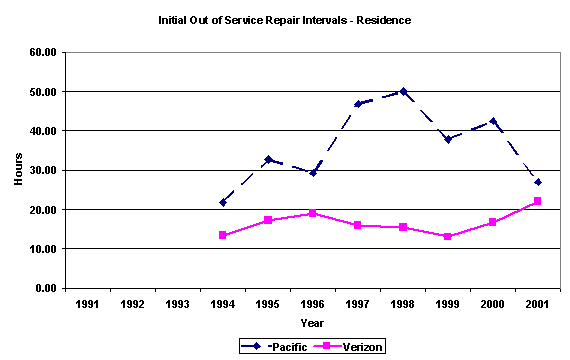
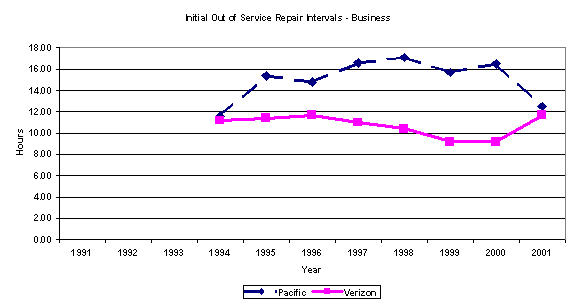
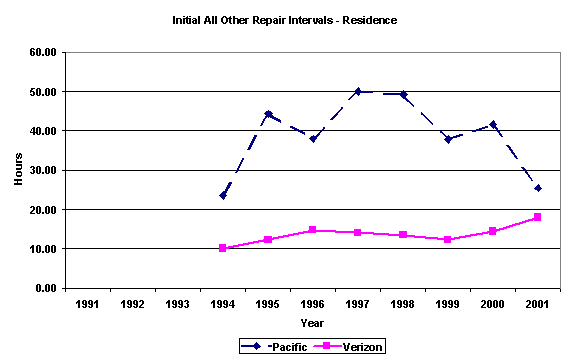
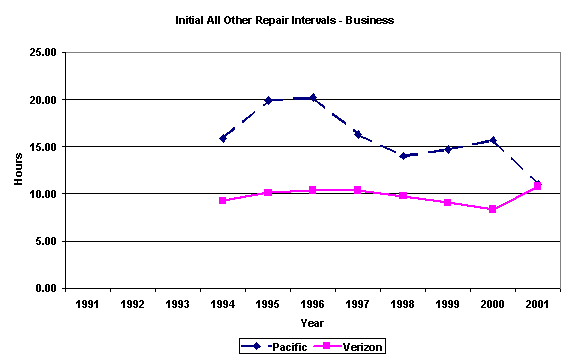
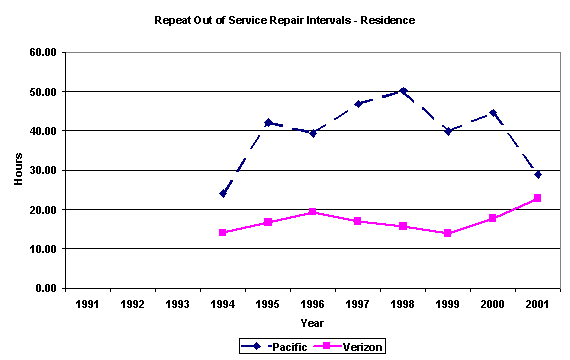
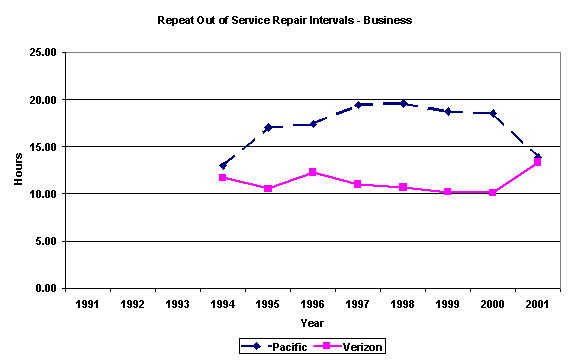

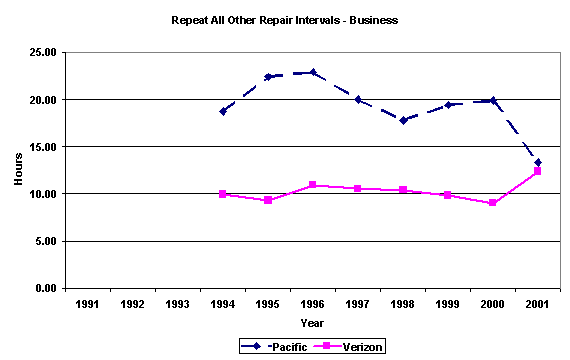
Pacific also generally performed worse than Verizon on trouble report numbers, although there were two categories in which Verizon performed worse and one in which the results were mixed. Pacific's results were worse than Verizon in 1) initial out of service trouble reports - residence; 2) initial out of service trouble reports - business; 3) repeat out of service trouble reports - residence; 4) repeat out of service trouble reports - business; and 5) repeat all other trouble110 reports - residence, as follows:
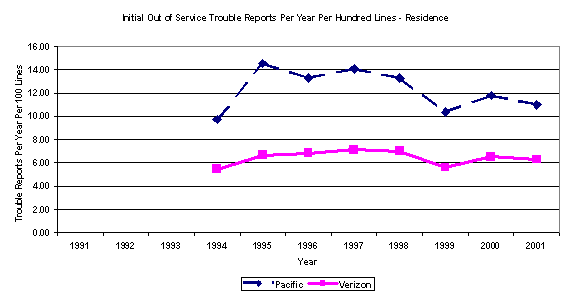
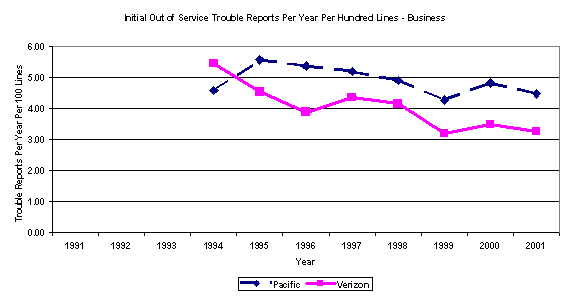
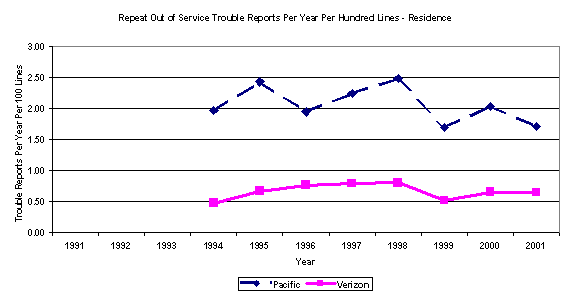
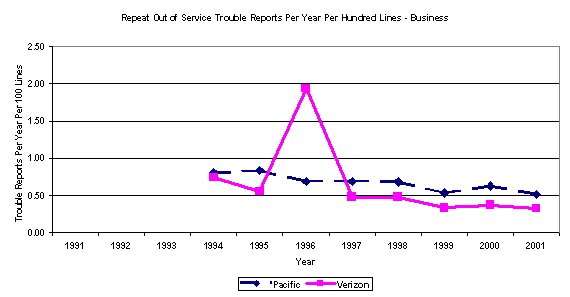
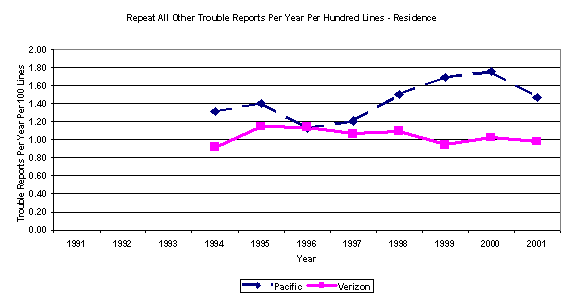 Pacific's results were better than Verizon's in the area of 1) initial all other trouble reports - business; and 2) repeat all other trouble reports - business, as follows:
Pacific's results were better than Verizon's in the area of 1) initial all other trouble reports - business; and 2) repeat all other trouble reports - business, as follows:
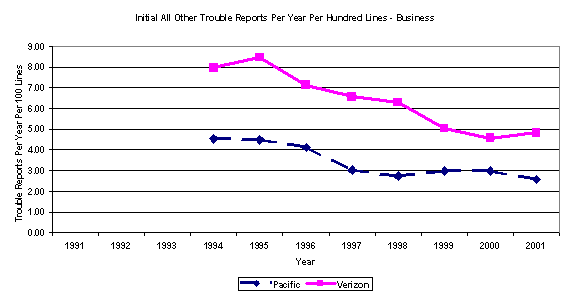
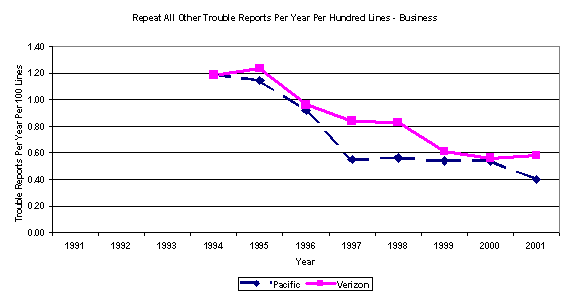 Finally, Pacific's results on initial all other trouble reports - residence were better than Verizon's during the period 1994-98, and exceeded Verizon's results in 1999-2001:
Finally, Pacific's results on initial all other trouble reports - residence were better than Verizon's during the period 1994-98, and exceeded Verizon's results in 1999-2001:
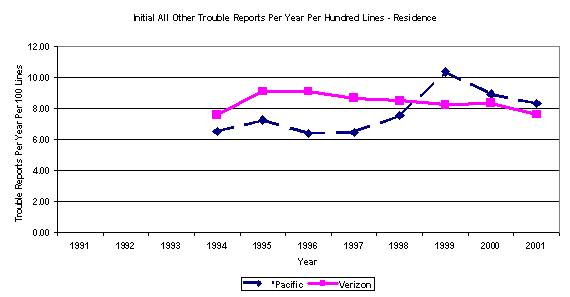
Overall, we find that Pacific shows numerous problems with repair intervals and trouble reports. While the trend in some areas was positive in 2001, it is too soon to tell where the trends are headed. Thus, we find that Pacific's trouble report counts and repair intervals merit serious consideration when we consider incentives to improve reporting and other NRF changes in Phase 3B of this proceeding.
4. Answer Times - Pacific
Pacific also demonstrated problems with its BOAT and TRSAT answer time performance. Its BOAT results during the period 1991-2001 show that in virtually all years, the percentage of calls Pacific answered within 20 seconds was below the standard. The BOAT measure was added to GO 133-B in 1992,111 and the minimum standard, measured as the percent of calls answered within 20 seconds, was progressively increased from 70% beginning on December 3, 1992, to 75% (beginning October 4, 1993), to 80% (beginning July 5, 1994).
The following graph shows both the GO 133-B standard in the relevant years and Pacific's (as well as Verizon's) performance. The data used in the graph has been adjusted for Pacific to include billing calls for the period beginning May 1999 and thereafter to make the data comparable for all years and for both companies.112 In all years but 1993 (when the carriers reported the same results) and 1997 (when Verizon reported slightly poorer results), Pacific's BOAT figures were worse than Verizon's:
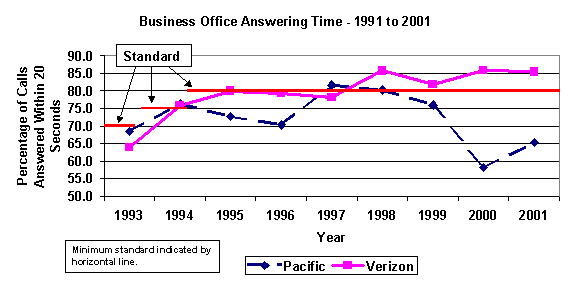
As we noted previously, Pacific changed its practices regarding inclusion of billing calls in its BOAT reporting, making comparison of its year-over-year performance difficult. Pacific now excludes billing calls, but included them in its GO 133-B reporting up until February 1999. TURN requested raw data from Pacific so that it could use consistent data to compare Pacific's performance to itself over time. Once TURN made adjustments to equalize the numbers, TURN found that, "Pacific's service quality has declined compared to itself since February 1999 and compared to Verizon. Pacific's combined performance on GO 133-B and billing calls has been 68% or less answered in 20 seconds during the years 2000 and 2001, a substantial decline from its 1997-1998 performance of meeting the GO 133-B of 80% in 20 seconds."113 Pacific did not attempt to refute TURN's calculations. Therefore, the figures in the foregoing graph reflect an adjustment of Pacific's results from 1999-2001 to add back estimated billing call answer times.
TURN alleges that Pacific's answer times for billing calls are so poor as to warrant a finding that Pacific has violated Pub. Util. Code § 451. Pacific only answered 20% of billing calls in 20 seconds at one point after February 1999 (GO 133-B requires 80% of business office calls to be answered in that time), and the rate has only improved to approximately 50% of late.114
However, both Pacific and TURN recognize that the Commission has not set standards for billing call answer times. This is a reporting gap that the Commission has identified for consideration in R.02-12-004. Therefore, we do not find a § 451 violation. Similarly, because GO 133-B specifically excludes billing inquiries from its measure of BOAT, we do not find that Pacific's performance of 68% or fewer calls answered within 20 seconds is a violation of GO 133-B standards, when billing calls are included in that measure.
However, we do find that, from the perspective of consumers, the undisputed data show that percentage of calls to a Pacific business office, including billing inquiries, answered within 20 seconds is lower than 1999 levels. This is a degradation of service quality. Moreover, the data in the foregoing graph shows that Pacific's BOAT times have, for all years except 1997, fallen below standards, as well as comparing unfavorably to Verizon's times. Thus, we find that Pacific shows significant problems with its BOAT results.
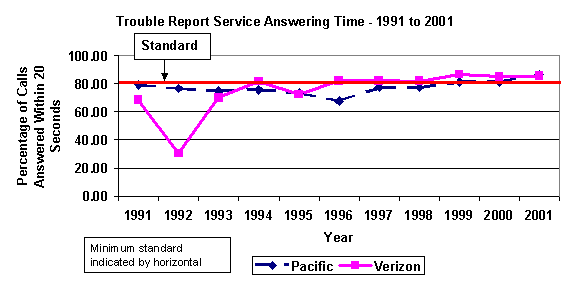 As for TRSAT results, Pacific's and Verizon's results are mixed over the period 1991-2001, as follows:
As for TRSAT results, Pacific's and Verizon's results are mixed over the period 1991-2001, as follows:
On average, Pacific's annual performance was below the standard from 1991 through 1998, and has been below Verizon's performance since 1996, when its performance reached its low ebb.115
We find that Pacific's most serious answer time problems lie with its BOAT results. It has shown sub-standard performance in the past on its TRSAT reports as well, but the pattern is less troubling and is trending in a positive direction.
5. Other Direct Measures of Service Quality - Pacific
a. Complaint Data - Pacific
(1) Formal Complaints
TURN relies on several formal Commission proceedings to make its case that service quality has declined under NRF. We discuss each in brief below. TURN also notes that the pace of such cases seems to have increased since 1995, indicating that the tendency for service quality decline under NRF has not diminished with the passage of time.
TURN's list of proceedings shows that there have been at least six proceedings finding serious problems with Pacific's service quality since 1995, as compared to two proceedings in the five-year period from January 1990-December 1994. TURN points to the following cases over the period 1991-present:
· C.91-03-006/D.93-05-062 regarding late payment charges. Pacific was found to have imposed erroneous late payment charges because it did not timely process payments as they came into its payment processing center. Mail sat around, and when it was finally processed, payments that had been timely made appeared to be late, causing Pacific incorrectly to assess late payment charges. The Commission pointed to some evidence that Pacific allowed the practice to continue in order to save money: "A letter to the Comptroller in May 1990 recognized that Pacific was taking improper action against customers and quoted a manager who believed that curing the problem may not be `worth spending a lot of money to obtain.'"116 The Commission required Pacific to refund $34 million in unlawful late charges, and to pay a $15 million fine.
· A.92-05-002/D.94-06-011 NRF review; settlement with ORA's predecessor, DRA, regarding Pacific's TRSAT answer times, among other things.117 ORA also alleges that Pacific violated the service quality requirements of D.94-06-011 because it failed to notify ORA by letter in 1994 about software changes related to Calling Cards, or conduct semi-annual meetings with Commission staff on "service quality results, to discuss concerns, and to discuss utility corrective measures."118 Pacific's witness conceded that Pacific could not substantiate that it sent ORA the required letter, and cited a later decision (D.97-03-067, discussed below) for the proposition that the Commission did not find Pacific to be out of compliance with the latter requirement.119 However, an examination of D.97-03-067 reveals no such statement by the Commission.
· A.95-12-043/D.97-03-021 regarding ISDN.120 The Commission found Pacific had insufficient staffing, and poor installation and customer service records, and noted that incentives to cut costs prevented Pacific from addressing the problem. We found that, "Pacific does not provide high quality customer services to its ISDN customers and potential ISDN customers . . . ."121
· A.96-04-038/D.97-03-067 regarding the Pacific Telesis/SBC merger.122 In this case, ORA's predecessor (DRA) presented evidence of Pacific's poor performance on its TRSAT and BOAT reports. DRA also claimed that an inadequate workforce caused service deterioration in the TRSAT. The Commission concluded in D.97-03-067 that, "ORA presented an impressive analysis of issues relating to Pacific's service quality which may be useful in other contexts." The Commission also found that "Pacific is and has been out of compliance with GO 133-B, apparently for some time. . . . Pacific failed to meet [the] standard for trouble report answering time almost 50% of the time for the period 1993 through the first six months of 1996 . . . ."123
The Commission also stated: "We are concerned by Pacific's failure to meet trouble report service answering time standards following our adoption of a settlement in D.94-06-011 under which Pacific, as a settling party, agreed to improve its trouble report service answering time in order to avoid the imposition of a penalty mechanism. In D.94-06-011, we found that `. . . Pacific will also be adjusting its procedures to improve its quality of service . . . .' (see page 118, D.94-06-011). Since that time, in fact, Pacific's service quality has declined."124 The Commission threatened Pacific with penalties if it did not improve its results in 90 days, and only then did Pacific's TRSAT and BOAT results improve.
· C.98-04-004/D.01-09-058 regarding Pacific marketing abuse.125 The Commission found that Pacific provided poor service quality and failed adequately to disclose information regarding its Caller ID, Wire Pro, and "The Basics" packaged services. Regarding service quality, the Commission stated that, "customer service quality is compromised when Pacific Bell representatives ask each caller, at the beginning of every call, for permission to access the subscriber's proprietary network information and to repeat the question if the answer is `no,' and force customers to listen to unwanted sales pitches prior to providing a response to a customer service inquiry. Therefore such practices are inconsistent with reasonable service quality."126
· C.99-06-053/D.01-10-071, in which Pacific was accused of deceptively marketing its "Saver 60" intraLATA toll calling plan. For some customers, Pacific was shown to have marketed the program to customers for whom it did not produce savings, despite Pacific's claims that it would. Pacific settled by agreeing to provide customers notification of the error, make refunds and establish a two-way feedback/complaint mechanism for telemarketing services.127
· C.99-16-018/D.01-12-021 regarding repair services. The Commission found Pacific's repair intervals had increased to such a level that they violated Pub. Util. Code § 451 and a Commission-ordered merger condition requiring that service quality be maintained. The Commission also found that Pacific did not inform customers of their right to be given a window of time within which a representative would complete required service. In reaching its findings, the Commission found that past performance is an adequate standard for determining service quality degradation in violation of Section 451,128 that cost cutting measures can cause such degradation,129 and that aggregation of data from multiple measures can mask service quality so poor in a single measure as to violate § 451.130
· C.02-01-007/D.02-10-073 regarding DSL. Settled with Commission adopting Pacific's proposed penalty payment into the State general fund of $27 million. Pacific agreed in the settlement that "During the period of January 2000 through the [date of the settlement agreement], an estimated 30,000 to 70,000 [of Pacific's DSL affiliate's] customers complained about and/or experienced billing errors" and that these errors "were not resolved in a timely manner and/or required multiple calls and substantial investment of time to resolve."131
Pacific does not appear to have addressed the formal complaint data TURN cites, except to note that those proceedings should not be considered part of the record of this proceeding, and are irrelevant to an assessment of Pacific's service quality during the NRF period.
We may take official notice of actions of this Commission pursuant to Rule 73. Thus, the formal complaints Commission proceedings TURN or any party cites with regard to Pacific (or Verizon) need not be a part of the record of this proceeding in order for us to rely on them in rendering this decision. Moreover, we disagree with Pacific's contention that its performance in the context of the listed formal proceedings is irrelevant here. This proceeding is our opportunity to examine the entirety of Pacific's record, and we find that these cases, when examined together, indicate that regulatory monitoring is essential to maintenance of good service quality.
TURN is correct that the pace of meritorious complaints has increased since 1995. We find that there were far fewer instances where the Commission has found violations of service quality rules or related matters during a similar time period preceding NRF. We cannot say, however, whether NRF itself caused the problem. Nonetheless, we do not believe that self-regulation is adequate to ensure proper performance and will continue to monitor Pacific's service quality performance closely. We should consider in Phase 3B of this proceeding whether the foregoing complaints give rise to a need for particular monitoring, systems of rewards and penalties, or other regulatory devices to maintain and improve service quality.
(2) Informal Complaints - Pacific
In the OII initiating this proceeding, the Commission listed informal complaint data for Pacific Bell in Appendix C, as follows:
Number of Informal Complaints Filed at the Commission
January 1, 1995, through July 12, 2001
Pacific Bell | ||||||||
Category of Complaint |
1995 |
1996 |
1997 |
1998 |
1999 |
2000 |
2001 | |
1 |
Delayed Orders & Missed Appoint. |
71 |
259 |
644 |
650 |
409 |
623 |
157 |
2 |
Quality of Service (e.g., static, crossed lines, intermittent service, etc.) |
947 |
1,416 |
1,780 |
1,639 |
1,095 |
1,324 |
380 |
3 |
Disputed Bill |
1,334 |
1,733 |
2,171 |
2,113 |
1,404 |
2,365 |
1,249 |
4 |
Disconnections |
93 |
186 |
286 |
441 |
306 |
500 |
173 |
5 |
Deposits |
111 |
100 |
191 |
176 |
128 |
104 |
43 |
6 |
Disputed Customer of Record |
166 |
121 |
206 |
239 |
238 |
134 |
55 |
7 |
No Notice |
39 |
65 |
104 |
125 |
127 |
15 |
0 |
8 |
Late Payment Charge |
12 |
6 |
10 |
10 |
13 |
0 |
0 |
9 |
Rate Design |
175 |
62 |
82 |
150 |
39 |
20 |
11 |
10 |
Rules |
363 |
272 |
465 |
249 |
78 |
152 |
82 |
11 |
Directory |
143 |
89 |
144 |
123 |
109 |
13 |
0 |
12 |
Company Practice |
459 |
376 |
319 |
303 |
131 |
498 |
249 |
13 |
Miscellaneous |
286 |
317 |
262 |
272 |
273 |
294 |
120 |
14 |
Baseline |
0 |
0 |
1 |
1 |
0 |
0 |
0 |
15 |
Surcharges/Taxes |
13 |
17 |
73 |
47 |
145 |
55 |
36 |
16 |
Number/Area Code |
2 |
31 |
48 |
48 |
46 |
18 |
8 |
17 |
Rate Protest |
8 |
24 |
6 |
105 |
11 |
3 |
6 |
18 |
Master/Sub Meters |
0 |
0 |
0 |
2 |
0 |
0 |
0 |
19 |
Bill Format |
5 |
5 |
18 |
4 |
10 |
1 |
0 |
20 |
Commission Policy/Practices |
2 |
1 |
1 |
1 |
4 |
0 |
0 |
21 |
Operator Services |
1 |
11 |
12 |
29 |
35 |
2 |
0 |
22 |
Annoyance Calls |
18 |
26 |
37 |
53 |
58 |
3 |
0 |
23 |
Payment Arrangements |
223 |
295 |
609 |
420 |
124 |
10 |
20 |
24 |
Commitment |
7 |
52 |
923 |
301 |
100 |
55 |
6 |
25 |
Pay Per Call Service |
65 |
44 |
94 |
26 |
17 |
3 |
1 |
26 |
Refusal to Serve |
40 |
53 |
141 |
70 |
10 |
1 |
2 |
27 |
Estimated Billing |
0 |
1 |
0 |
1 |
0 |
0 |
1 |
28 |
Deaf Program |
0 |
1 |
1 |
2 |
7 |
2 |
2 |
29 |
Balance/Level Pay Plan |
0 |
0 |
0 |
1 |
0 |
0 |
0 |
30 |
Illegal Activities |
0 |
0 |
0 |
1 |
0 |
6 |
0 |
31 |
COPT |
9 |
12 |
8 |
9 |
3 |
2 |
1 |
32 |
Custom Calling Features |
160 |
426 |
129 |
294 |
271 |
472 |
42 |
33 |
Inside Wiring |
98 |
54 |
70 |
100 |
62 |
28 |
6 |
34 |
Abusive Marketing |
41 |
41 |
48 |
53 |
93 |
86 |
26 |
35 |
Backbilling |
0 |
0 |
8 |
12 |
21 |
7 |
1 |
36 |
Centralized Credit Check System |
21 |
7 |
4 |
29 |
59 |
7 |
0 |
37 |
Female/Minority Business Enterprise |
0 |
1 |
4 |
2 |
0 |
0 |
0 |
38 |
Mergers |
0 |
5 |
0 |
0 |
1 |
0 |
0 |
39 |
Low Income Programs |
17 |
9 |
11 |
2 |
18 |
10 |
10 |
40 |
New Incentive Regulatory |
274 |
7 |
6 |
7 |
13 |
5 |
2 |
41 |
Safety |
0 |
5 |
9 |
10 |
4 |
11 |
3 |
42 |
Electromagnetic |
0 |
0 |
0 |
1 |
0 |
0 |
0 |
43 |
Landline to Cellular |
0 |
0 |
0 |
2 |
4 |
0 |
0 |
44 |
Improper Advertising |
0 |
0 |
0 |
13 |
8 |
1 |
0 |
45 |
Cramming |
0 |
0 |
1 |
30 |
27 |
77 |
75 |
46 |
Outages |
0 |
0 |
0 |
4 |
7 |
64 |
15 |
47 |
Anonymous Call Rejection |
0 |
0 |
0 |
21 |
5 |
0 |
0 |
48 |
Prepaid Phone Card |
0 |
0 |
0 |
0 |
2 |
3 |
2 |
TOTALS |
5,203 |
6,130 |
8,926 |
8,191 |
5,515 |
6,974 |
2,784 | |
In Exhibit 2B:701(C),132 the Commission's legal staff clarified how the data in the foregoing table were derived. The data were compiled from summary reports maintained in the database of the Commission's Consumer Affairs Branch (CAB). An informal complaint, as the term is used in the context of the foregoing data, "is one that is handled by CAB staff in an attempt to come to a mutually agreed upon resolution between the consumer and the utility."133 The numbers do not include formal complaints, which "consumers may also file . . . with the Commission and [which] are handled by the ALJ Division." CAB also furnished Pacific Bell the underlying data from which it compiled the results.
Pacific did not object to receipt of the complaint information into evidence.134 Thus, we will assume the informal complaint figures are valid as reported. As ORA points out, Pacific critiqued the foregoing data from the OII Appendix C, but then used the information to draw its own favorable conclusions about its service quality.135 Therefore, it is appropriate for us to use the data to draw our own conclusions about Pacific's service quality.
Because the informal complaint data were not organized into categories reflective only of service quality problems, we have summarized the results of complaints that relate most directly to service quality. The results are as follows:
PACIFIC COMPLAINT DATA BY SERVICE QUALITY RELATED CATEGORIES | ||||||||
(1995 - July 12, 2001) | ||||||||
Pacific | ||||||||
1995 |
1996 |
1997 |
1998 |
1999 |
2000 |
2001* |
Total | |
Abusive Marketing |
41 |
41 |
48 |
53 |
93 |
86 |
26 |
388 |
Quality of Service |
947 |
1416 |
1780 |
1639 |
1095 |
1324 |
380 |
8581 |
Operator Services |
1 |
11 |
12 |
29 |
35 |
2 |
0 |
90 |
Safety |
0 |
5 |
9 |
10 |
4 |
11 |
3 |
42 |
Outages |
0 |
0 |
0 |
4 |
7 |
64 |
15 |
90 |
Delayed Orders & Missed Appts |
71 |
259 |
644 |
650 |
409 |
623 |
157 |
2813 |
Missed Commitments |
7 |
52 |
923 |
301 |
100 |
55 |
6 |
1444 |
TOTAL |
1067 |
1784 |
3416 |
2686 |
1743 |
2165 |
587 |
13448 |
*Partial year data
 It is difficult to analyze these data in all their possible permutations, but we can make at least two observations. First, informal complaints were at their worst in 1997-98 and 2000. Thus, any problems Pacific may have are not remote in time, but rather stem from recent years. Second, the ratio of service quality complaints to overall complaints has fluctuated significant over the years, with 1997-98 and 2000 the worst years in this category:
It is difficult to analyze these data in all their possible permutations, but we can make at least two observations. First, informal complaints were at their worst in 1997-98 and 2000. Thus, any problems Pacific may have are not remote in time, but rather stem from recent years. Second, the ratio of service quality complaints to overall complaints has fluctuated significant over the years, with 1997-98 and 2000 the worst years in this category:
65 D.02-09-050, mimeo., at 263, available at http://www.cpuc.ca.gov/WORD_PDF/FINAL_DECISION/19433.doc.
66 In R.98-06-029, initiated just two years after competition was authorized in the local exchange market, the Commission noted that "customers' perception that the quality of telephone service provided by local exchange carriers has declined over the last few years," citing significant increases in complaints related to service quality. R.98-06-029, mimeo., at 9, 67 R.02-12-004, mimeo., at 9. 68 TURN further claims that competition does not provide an incentive for good service quality under NRF. It contends that Pacific's own witness on this point, Dr. Harris, has made contrary claims in the past, stating that "[p]erhaps the greatest misconception about the effects of competition on quality is that competition improves service quality: IT DOES NOT." TURN Opening/Service Quality at 10, citing Dr. Robert G. Harris, "Principles of Service Quality Regulation in Retail Telecommunications Services," commissioned by Pacific Bell, August 24, 1998, at 10, Attachment 3 to Opening Comments of Pacific Bell in R.98-06-029 (GO 133-B), August 25, 1998 (emphasis in original), cited in Exh. 2B:506 (Murray Reply Testimony) at 9-10. Pacific claims TURN took this quote out of context and that Dr. Harris simply was making the point that price, and not just quality, drive customer choice in a competitive marketplace. We conclude that Dr. Harris' quote contradicts his testimony about the effects of competition on service quality in this proceeding, bolstering our decision in this area. 69 Errata to Opening Brief of the Office of Ratepayer Advocates in Service Quality in Phase 2B, filed Sept. 10, 2002, at 1; Second Errata to Opening Brief of the Office of Ratepayer Advocates on Service Quality in Phase 2B, filed Sept. 11, 2002, at 1. 70 Our rejection of ORA's recommendation does not in any way preclude the Commission staff from reviewing in the future Pacific's service quality data or its data collection and reporting methods. Similarly, in denying this recommendation, we do not intend to preclude proposals in Phase 3B designed to ensure the accuracy of data reported to regulators, through audits or any other means. 71 Indeed, Pacific's own staff worked on testing Ms. Young's results, making clear that Pacific was well aware of the ORA's purpose for requesting the data. Exh. 2B:357 at 29 (Resnick Reply Testimony) ("At my direction, several analysts in [Pacific's] Network Services [organization] have worked with the data supplied by Ms. Young in her workpapers."). 72 Pacific Reply/Service Quality at 15. 73 ORA Opening/Service Quality at 16, citing 22 RT 2796:1-3 (Resnick). 74 ORA Reply/Service Quality at 3. 75 Id. at 5. 76 Id. 77 ORA Reply/Service Quality at 8, citing Pacific's Tariff, Schedule Cal. P.U.C. No. A2. Network and Exchange Services: A2. General Regulations 2.1.1 Rule No. 1 - DEFINITION OF TERMS. 78 ORA Opening/Service Quality at 10 (citations omitted). 79 1997 Cal. PUC LEXIS 142. The Commission found Pacific had insufficient staffing, and poor installation and customer service records, and noted that incentives to cut costs prevented Pacific from addressing the problem. In connection with that complaint, we concluded that based on Pacific's staffing, installation performance and record-keeping, "Pacific does not provide high quality customer services to its ISDN customers and potential ISDN customers . . . ." Id. at *50, finding of fact 17. See also Exh. 2B:507 at 10-11 (Schilberg Direct Testimony). 80 TURN Opening/Service Quality at 16. 81 TURN Opening/Service Quality at 17. 82 Pacific Opening/Service Quality at 11. 83 Id. at 18. 84 The installation interval and commitments met graphs are based on ARMIS data reported by carriers to the FCC. Prior to 1996, carriers reported ARMIS data on a quarterly basis, and thereafter, annually. For years reporting quarterly data, quarterly installation orders are summed to obtain annual installation orders. Annual installation intervals and commitments met are obtained by weighting and combining the quarterly data (i.e., multiplying quarterly installation intervals or commitments met by quarterly installation orders, summing the results and dividing the summed result by annual installation orders). Similarly, Verizon's annual installation orders and commitments met are obtained by summing GTE California and Contel installation orders. Verizon's installation intervals and commitments met are obtained by weighting and combining the GTEC and Contel installation intervals or commitments met. 85 http://www.fcc.gov/wcb/mcot/SBC_AIT/service_quality/IN1.pdf. 86 http://www.fcc.gov/wcb/mcot/SBC_AIT/service_quality/IN2.pdf. 87 Exh. 2B:132 at 8 (Young Opening Testimony). 88 Exh. 2B:355 at 9 (Hauser Reply Testimony). 89 The ARMIS reports appear in the record as Exhibits 704 and 706. 90 Exh. 2B:354, Attachment 16 (Hauser Direct Testimony). 91 D.01-02-021, mimeo., at 8 & n.4; see also TURN Opening/Service Quality at 19. 92 D.01-02-021, mimeo., at 11. 93 Id. at 48. 94 We note, however, Pacific's initial out of service repair interval for residential customers of 42.49 hours for November 2002 exceeds by more than 13 hours the standard of 29.3 hours established in D.01-12-021. Pacific attributes its missed objective to weather. Report of November 2002 ARMIS Data for Repair Intervals in Compliance with D.01-12-021. 95 D.01-09-058, 2001 Cal. PUC LEXIS 914, at *146, finding of fact 62. 96 "Initial out-of-service trouble reports" are defined as trouble reports concerning service quality in which the customer is totally without phone service. See Exh. 2B:133 at 3 n.1 (Hieta Opening Testimony). 97 See ORA Opening/Service Quality, at 12, citing Exh. 2B:133 at 3-4 (Hieta Opening Testimony). 98 "Repeat out-of-service trouble reports" are defined as customer trouble reports concerning service quality that are received within thirty days after the resolution of an initial trouble report on the same line. See Exh. 2B:133 at 4 n.2 (Hieta Opening Testimony). 99 Exh. 2B:133 at 4 (Hieta Opening Testimony). 100 Exh. 2B:507 at 34, Figure 13 (Schilberg Direct Testimony). See also Exh. 2B at 8-9, Figure 5 (Hieta Opening Testimony). 101 "All other trouble reports" are defined as reports besides out-of-service trouble reports. See Exh. 2B:133 at 7 n.5 (Hieta Direct Testimony). 102 ORA Opening/Service Quality at 13, citing Exh. 2B:133 at 8 (Hieta Opening Testimony). 103 ORA Opening/Service Quality at 13, citing Exh. 2B:133 at 9. 104 Exh. 2B:133 at 13 (Hieta Opening Testimony). According to its witness, ORA based these figures on an analysis of raw repair data Pacific furnished ORA. Pacific used the raw repair data to calculate ARMIS numbers for the years 2000 and 2001. Id. at 12. 105 Exh. 2B:133 at 11-12 (Hieta Opening Testimony). 106 Pacific Reply/Service Quality at 28. 107 Whereas Pacific's repeat out-of-service reports as a percentage of initial out-of-service trouble reports for California residence customers n the range of 14.7 percent to 20.2 percent during the 1994-2001 period, Verizon's comparable percentages ranged from 8.9 percent to 11.4 percent. Exh. 2B:133 at 11, Table 1 (Hieta Direct Testimony). 108 The trouble report graphs are based on ARMIS data reported by carriers to the FCC. Prior to 1996, carriers reported ARMIS data on a quarterly basis, and thereafter, annually. For years reporting quarterly data, quarterly results are summed to obtain annual trouble reports. Annual repair intervals are obtained by weighting and combining the quarterly data (i.e., multiplying quarterly repair intervals by quarterly by trouble reports, summing the results and dividing the summed result by annual trouble reports). Similarly, Verizon's annual trouble reports are obtained by summing GTE California (GTEC) and Contel trouble reports, and Verizon's repair intervals are obtained by weighting and combining the GTEC and Contel repair intervals. 109 These categories are: 1) initial out of service repair intervals - residence; 2) initial out of service repair intervals - business; 3) initial all other repair intervals - residence; 4) initial all other repair intervals - business; 5) repeat out of service repair intervals - residence; 6) repeat out of service repair intervals - business; 7) repeat all other repair intervals - residence; and 8) repeat all other repair intervals - business. 110 All other trouble reports are all trouble reports except those involving out of service conditions. 111 D.92-05-056. 112 Verizon includes billing related calls in its reported BOAT data, while Pacific began excluding billing related calls from its BOAT reports beginning May 1999. Pacific's adjusted BOAT data is from TURN's August 27, 2002 Supplemental Testimony. 113 Id., citing Exh. 2B:521 (Schilberg Supplemental Testimony). 114 Exh. 2B:521, Table 1. 115 Because monthly calls volumes are not part of the record, annual averages were estimated by summing the monthly results and dividing by 12. 116 D.93-05-062, mimeo., at 15, 1993 Cal. PUC LEXIS 394, at *21. 117 1994 Cal. PUC LEXIS 456, at *158-59. 118 D.94-06-011, Appendix B, Section 4.B. SERVICE QUALITY. 119 Exh. 2B:357 at 48:6-14 (Resnick Reply Testimony) & 23 RT 2976:3-24 (Resnick). 120 1997 Cal. PUC LEXIS 142. ISDN was an early means of boosting the capacity of existing copper connections between a customer's premises and Pacific's switching facilities. 121 Id. at *50, finding of fact 17. See also Exh. 2B:507 at 10-11 (Schilberg Direct Testimony). 122 1997 Cal. PUC LEXIS 629, at *131, 71 CPUC 2d 351, 395 (1997). 123 D.97-03-067, 1997 Cal. PUC LEXIS 629, at *131, 71 CPUC 2d 351, 395 (1997). 124 D.97-03-067, 1997 Cal. PUC LEXIS 629, at *130. 125 2001 Cal. PUC LEXIS 914. 126 2001 Cal. PUC LEXIS 914, at *155. 127 D.01-10-071, 2001 Cal. PUC LEXIS 961, at *9-10. 128 D.01-12-021, mimeo., at 11, findings of fact 20, 21 at 44-45, & conclusion of law 6 at 45, 2001 Cal. PUC LEXIS 1075, at *20-21 & 73. 129 Id., mimeo. at 10, citing D.01-03-039, mimeo., at 33. 130 Id. at 23 & finding of fact 16 at 44. 131 D.02-10-073, mimeo., at 8. 132 The "C" designates a confidential exhibit. However, none of the summary statistics contained in Appendix C to the OII in this decision require confidential treatment, as they do not identify individual customers or otherwise compromise the trade secrets of any telephone company. 133 Id. 134 See 23 RT 2998:10-25. 135 ORA Reply/Service Quality at 26-27 (citing Pacific witness Flynn as stating "It is difficult to draw any definite conclusions based on the data in Appendix C because we were unable to obtain full answers regarding how the data is collected andprocessed. . . .).



